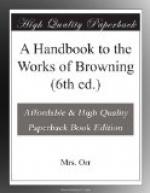Index to names and titles in “Ferishtah’s Fancies;”—
P. 12. “Shah
Abbas.” An historical personage used
fictitiously.
P. 15. “Story of Tahmasp.” Fictitious.
P. 16. “Ishak son of Absal.” Fictitious.
P. 20. “The householder of Shiraz.” Fictitious.
P. 32. “Mihrab Shah.” Fictitious.
P. 36. “Simorgh.” A fabulous creature in Persian mythology.
P. 40. The “Pilgrim’s soldier-guide.” Fictitious.
P. 41. “Raksh.”
Rustum’s horse in the “Shah Nemeh.”
(Firdausi’s “Epic
of Kings.”)
P. 50. (Anglice),
“Does Job serve God for nought?” Hebrew
word at p. 51, line
2, “M[=e] El[=o]h[=i]m”: “from
God.”
P. 54. “Mushtari.” The planet Jupiter.
P. 65. “Hudhud.” Fabulous bird of Solomon.
P. 68. “Sitara.” Persian for “a star.”
P. 85. “Shalim Shah.” Persian for “King of kings.”
P. 86. “Rustem,”
“Gew,” “Gudarz,” “Sindokht,”
“Sulayman,”
“Kawah.”
Heroes in the “Shah Nemeh.”
P. 87. The “Seven
Thrones.” Ursa Major. “Zurah.”
Venus.
“Parwin.”
The Pleiades. “Mubid.” A kind
of mage.
P. 88. “Zerdusht.” “Zoroaster.”
“PARLEYINGS WITH CERTAIN PEOPLE OF IMPORTANCE IN THEIR DAY.”
This volume occupies, even more than its predecessor, a distinctive position in Mr. Browning’s work. It does not discard his old dramatic methods, but in a manner it inverts them; Mr. Browning has summoned his group of men not for the sake of drawing their portraits, but that they might help him to draw his own. It seems as if the accumulated convictions which find vent in the “parleyings” could no longer endure even the form of dramatic disguise; and they appear in them in all the force of direct reiterated statement, and all the freshness of novel points of view. And the portrait is in some degree a biography; it is full of reminiscences. The “people” with whom Mr. Browning parleys, important in their day, virtually unknown in ours, are with one exception his old familiar friends: men whose works connect themselves with the intellectual sympathies and the imaginative pleasures of his very earliest youth. The parleyings are:
I.
“With Bernard de Mandeville.”
II. “With
Daniel Bartoli.”
III. “With
Christopher Smart.”
IV. “With
George Bubb Dodington.”
V.
“With Francis Furini.”
VI. “With
Gerard de Lairesse.”
VII. “With
Charles Avison.”
They are enclosed between a Prologue and an Epilogue both dramatic and fanciful, but scarcely less expressive of the author’s mental personality than the body of the work.
“Apollo and the
Fates.”
“Fust and his
Friends.”




